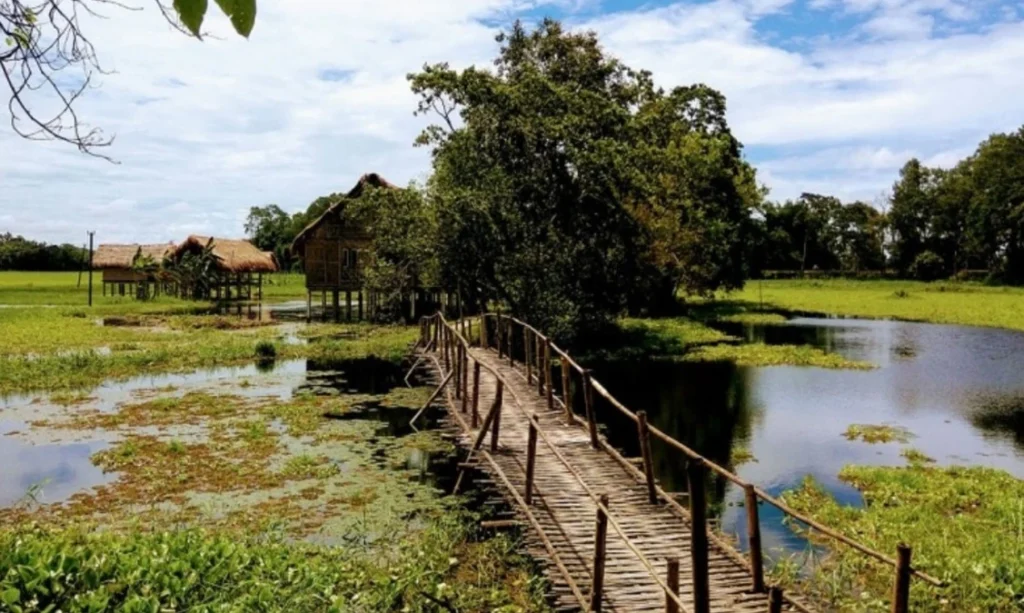“Discover Majuli District, the world’s largest river island on the Brahmaputra. Explore vibrant culture, serene landscapes, and ancient Assamese heritage.”

Majuli District: Assam’s Island Paradise
Majuli, located in the northeastern state of Assam, is not your typical district. It’s an island, and one of the largest river islands in the world. Nestled between the mighty Brahmaputra River and its tributaries, Majuli is a land of pristine natural beauty, vibrant culture, and a unique way of life. Covering an area of approximately 450 square kilometers, Majuli District is a treasure trove of biodiversity and cultural heritage.
The island’s geography is constantly changing due to erosion and deposition by the Brahmaputra. It’s a dynamic landscape that has shaped the lives of the people who call it home. The residents of Majuli are mainly Mishing and Deori tribes, who have adapted to the island’s ever-shifting contours. Fishing and agriculture are the primary occupations here, and the fertile soil ensures bountiful harvests.
What truly sets Majulli apart is its rich cultural heritage. The island is a hub of Assamese art, music, and dance. The Neo-Vaishnavism movement, initiated by the revered saint Srimanta Sankardeva in the 15th century, finds its epicenter here. The Vaishnavite monasteries, locally known as “Satras,” are the heart of Majuli’s cultural tapestry. These monasteries are not just religious centers but also bastions of traditional performing arts like Borgeet (devotional songs), Sattriya dance, and Ankia Naat (one-act plays). Majuli’s annual Raas Leela festival, celebrated with great pomp and show, is a testament to its rich cultural heritage.
For nature enthusiasts, Majulli is a paradise. The island is a hotspot for birdwatching, with numerous migratory and resident bird species. The lush green landscape is dotted with wetlands, providing ideal breeding grounds for various bird species. The Molai forest, often referred to as the “Forest Man of India,” is a remarkable example of reforestation efforts. Jadav Payeng, the man behind this project, single-handedly planted a forest that now spans over 1,360 acres.
The Brahmaputra itself is the lifeline of Majuli. The river not only shapes the island’s topography but also provides livelihoods to the people. Boat rides on the Brahmaputra are a must-do activity when visiting Majulli. Watching the sunset over the river is a breathtaking experience that stays etched in the memory of every traveler.
Despite its undeniable beauty and cultural significance, Majuli faces environmental challenges. Erosion caused by the Brahmaputra threatens to swallow parts of the island every year. Efforts are underway to combat this issue, including the construction of embankments and the planting of bamboo groves to stabilize the banks.
In recent years, Majuli has gained recognition as a unique tourism destination. Travelers seeking an authentic cultural experience and a glimpse into Assam’s natural beauty flock to this island. The district administration and local communities are working together to promote sustainable tourism, ensuring that Majuli’s pristine environment and cultural heritage are preserved for future generations.
Majuli District, with its ever-evolving landscape, vibrant culture, and ecological significance, is a testament to the resilience of the human spirit in harmony with nature. It is a place where traditions thrive, and the beauty of the Brahmaputra mesmerizes all who set foot on its shores. Majuli is not just an island; it’s a living testament to the rich tapestry of life and culture that defines Assam.
Famous Places in Majuli District
Majuli District is known for its cultural and natural attractions. Here are some of the famous places to visit in Majuli:
Kamalabari Satra: This is one of the most renowned Vaishnavite monasteries on the island. It’s not only a spiritual center but also a hub for traditional arts and cultural performances.
Auniati Satra: Another important religious institution, Auniati Satra is famous for its grand celebration of the Raas Leela festival. It’s a great place to witness Assamese art forms and craftsmanship.
Garmur: This historical site is believed to be the original seat of the Neo-Vaishnavism movement initiated by Srimanta Sankardeva. The Sankardeva Sangrahalaya museum here provides insights into his life and teachings.
Samaguri Satra: Known for its mask-making tradition, Samaguri Satra is where you can observe artisans creating colorful masks used in traditional Bhaona performances.
Tengapania: A picturesque village on Majuli, Tengapania offers serene landscapes, paddy fields, and a chance to experience the tranquil rural life of the island.
Dakhinpat Satra: This Satra is famous for its extensive collection of ancient Assamese scriptures and artifacts. It’s a treasure trove for history enthusiasts.
Molai Forest: Visit the incredible Molai Forest, a man-made forest created by Jadav Payeng over several decades. It’s a testament to one person’s dedication to environmental conservation.
Brahmaputra River: The river itself is a major attraction. Take a boat ride to witness the breathtaking sunset over the Brahmaputra, and don’t miss the opportunity for birdwatching.
Kamalabari Village: Explore the quaint village of Kamalabari, known for its traditional Assamese houses and warm hospitality.
Tingkhong Village: Tingkhong is famous for its pottery. You can watch skilled artisans create intricate clay pottery and even try your hand at it.
These are just a few of the many attractions that Majuli District has to offer. Whether you’re interested in culture, spirituality, nature, or simply a peaceful escape, Majuli has something to offer every traveler.
Read More :-
